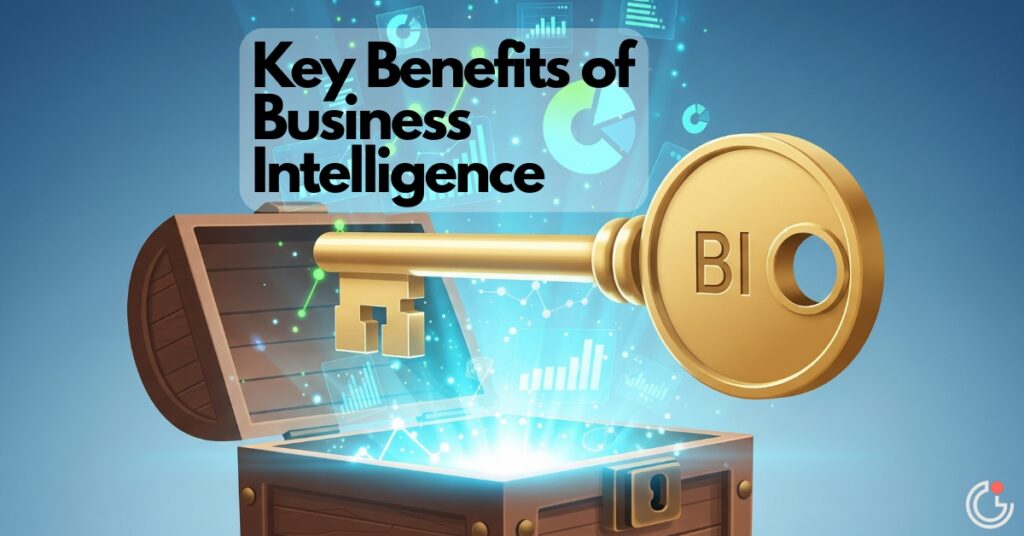Unlock explosive growth for your e-commerce business. Discover the key benefits of using Business Intelligence (BI) to enhance customer understanding, optimize pricing, boost sales, and gain a competitive edge.
In the hyper-competitive world of e-commerce, gut feelings and guesswork just don’t cut it anymore. Thriving online stores aren’t just lucky; they’re smart. They leverage the power of their own data to make faster, more accurate decisions. The secret weapon behind this data-driven success is Business Intelligence (BI).
If you’ve heard the term “BI” but aren’t sure how it applies to your online store, you’re in the right place. Think of BI as a powerful magnifying glass for your business data. It takes all the raw, scattered information your store generates—sales figures, customer clicks, inventory levels, marketing campaign results—and transforms it into clear, actionable insights. By using BI, you can move from asking “What happened?” to understanding “Why did it happen?” and, most importantly, “What should we do next?”
This guide will walk you through the transformative 11 Key Benefits of Business Intelligence for Your Online Store benefits of integrating BI into your e-commerce operations, turning your data from a dormant asset into your most powerful driver of growth.
Table of Contents
What Exactly Helps is Business Intelligence? A Simple Breakdown
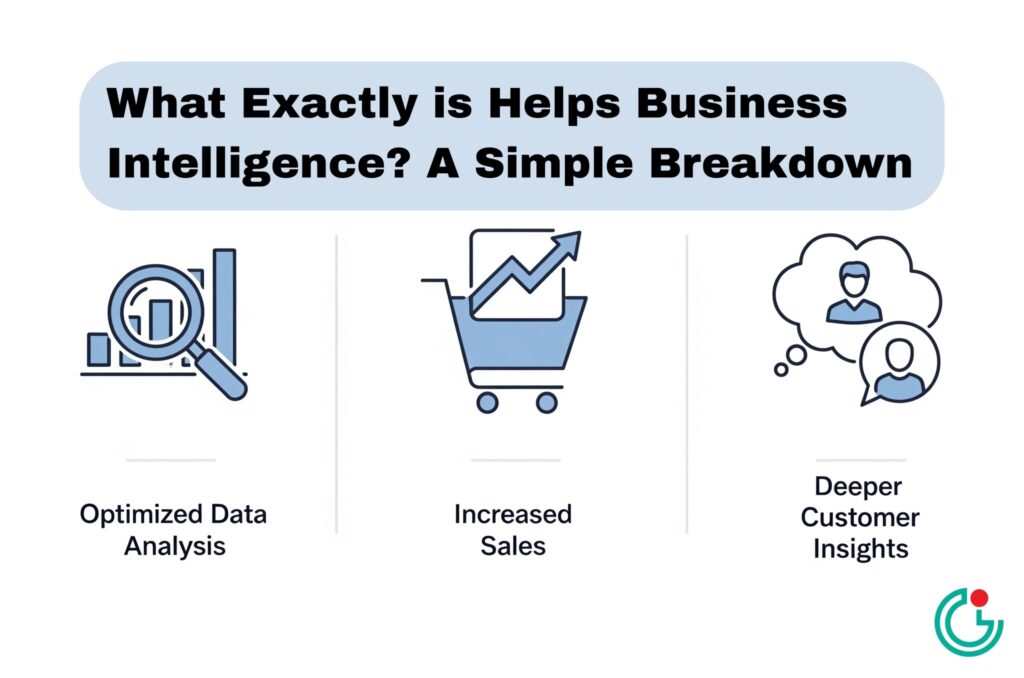
Before we dive into the benefits, let’s quickly demystify what Business Intelligence is.
At its core, Business Intelligence is a technology-driven process for analyzing data and presenting actionable information to help business leaders, managers, and other end-users make more informed business decisions.
It’s a broad umbrella term that covers several related activities and tools:
- Data Collection: Gathering data from all your sources (website, CRM, social media, payment gateways, etc.).
- Data Storage: Keeping this data safe and organized in a central repository, often called a data warehouse.
- Data Analysis: Using tools and techniques to query the data and find patterns, trends, and anomalies.
- Data Visualization: Presenting these findings in an easy-to-understand format, like charts, graphs, and interactive dashboards.
Popular BI tools you might have heard of include Microsoft Power BI, Tableau, and Google Data Studio. These platforms connect to your data sources and allow you to build custom reports and dashboards that track the health of your online store in real-time.
Now, let’s explore the game-changing 11 Key benefits of Business Intelligence for Your Online Store: Supercharge Your Sales
1. Deepen Your Customer Understanding
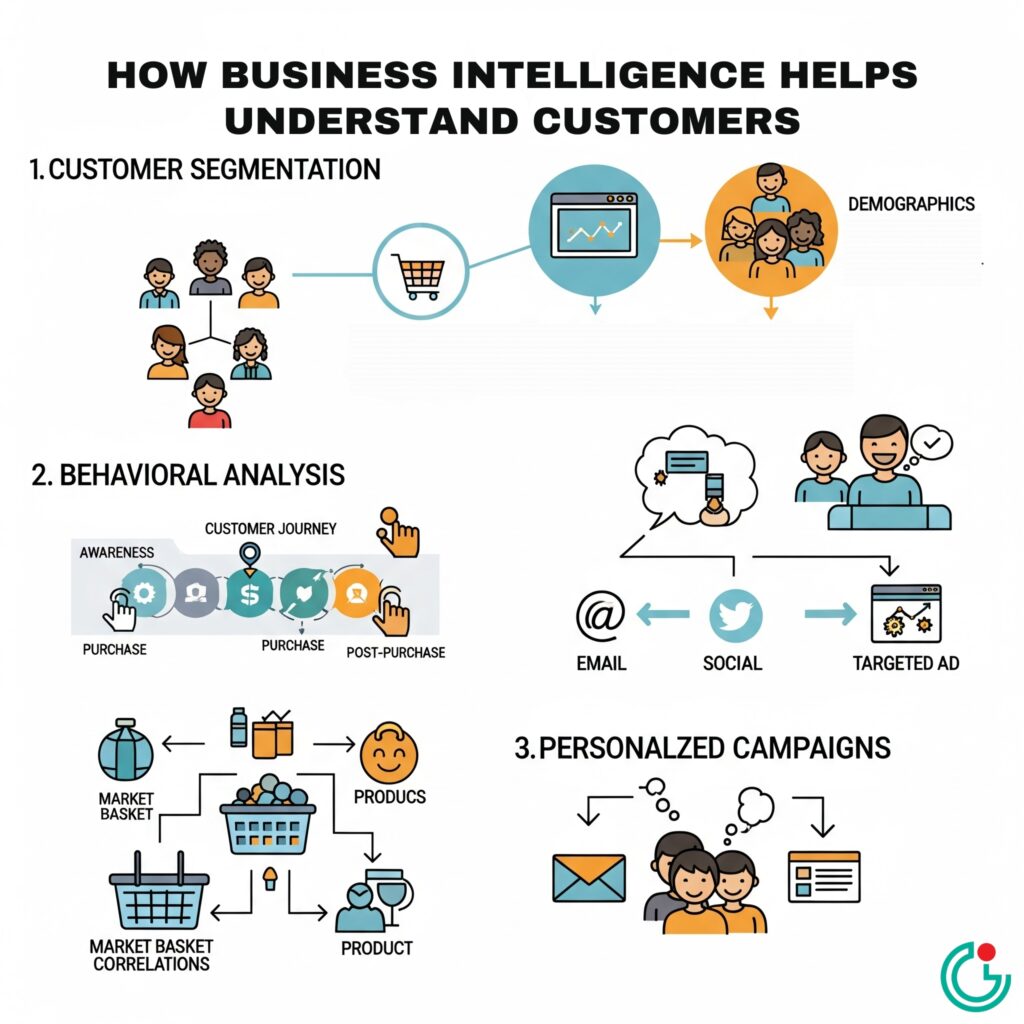
Your customers are the lifeblood of your store, but do you truly understand them? BI helps you move beyond basic demographics to grasp their behaviors, preferences, and motivations on a profound level.
Granular Customer Segmentation
BI tools allow you to slice and dice your customer base into highly specific segments. Instead of a one-size-fits-all approach, you can group customers based on:
- Purchase History: High-spenders, one-time buyers, frequent shoppers.
- Browse Behavior: Which product categories they view most, how much time they spend on pages.
- Geographic Location: Tailoring offers to specific cities or countries.
- Acquisition Channel: Customers from organic search, social media ads, or email campaigns.
With these segments, you can create targeted marketing campaigns that resonate deeply with each group, drastically improving engagement and conversion rates.
Analyze Purchase Patterns and Behavior
Why do some customers buy a product, while others abandon their cart? BI helps you answer this. By analyzing user session data, you can track the entire customer journey, from the first click to the final purchase. This reveals:
- Popular navigation paths on your site.
- Drop-off points in the conversion funnel.
- Correlations between products (market basket analysis), helping you identify which items are frequently bought together.
For example, you might discover that customers who buy hiking boots often return a week later to buy high-performance socks. Armed with this insight, you can create a “Frequently Bought Together” bundle on the hiking boots product page, instantly increasing the Average Order Value (AOV).
2. Optimize Pricing and Promotions Strategically

Setting the right price is a delicate balance. Price too high, and you scare customers away. Price too low, and you leave money on the table. BI replaces guesswork with data-backed pricing strategies.
Dynamic Pricing Models
By analyzing competitor prices, demand trends, inventory levels, and even the time of day, BI systems can help you implement dynamic pricing. This means prices can adjust automatically to maximize revenue. For example, you could slightly increase the price of a popular item when inventory is low or when a competitor runs out of stock.
Measure Promotion Effectiveness
Did that “20% Off” flash sale actually boost your bottom line, or did it just eat into your profit margins? BI gives you a clear picture of your promotional performance. You can track key metrics like:
- Increase in traffic and sales during the promotion.
- Profit margin on discounted items.
- The number of new vs. returning customers acquired.
This allows you to refine your promotional calendar, ditching ineffective strategies and doubling down on what works.
3. Drastically Improve Inventory Management
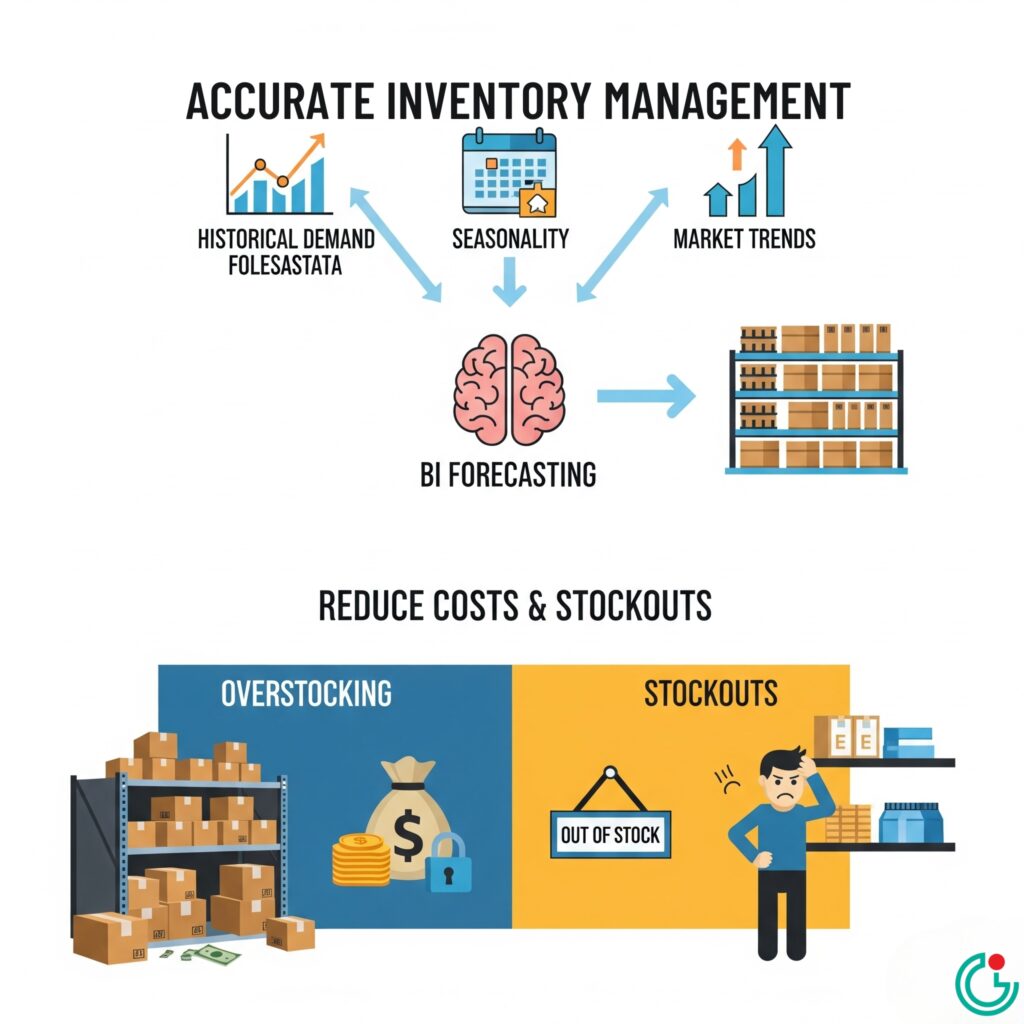
Inventory is one of the biggest challenges for any online store. Too much stock ties up capital and increases storage costs, while too little leads to stockouts and lost sales. BI brings precision and foresight to your inventory control.
Accurate Demand Forecasting
Stop guessing how much stock you’ll need. BI tools use historical sales data, seasonality, and market trends to create highly accurate demand forecasts. You’ll know exactly which products will be hot during the holidays and which will see a slump in the summer. This proactive approach ensures you have the right products in the right quantity at the right time.
Reduce Holding Costs and Prevent Stockouts
By optimizing your inventory levels, you directly impact your profitability.
- Prevent Overstocking: Avoid tying up cash in slow-moving products and reduce warehousing costs.
- Eliminate Stockouts: Nothing frustrates a customer more than an “Out of Stock” message. Accurate forecasting ensures your best-sellers are always available, protecting you from losing sales to competitors.
BI can also help you set up automated reorder points, so when stock for a particular SKU (Stock Keeping Unit) hits a certain threshold, you’re automatically notified to place a new order.
4. Increase Sales and Conversion Rates

Ultimately, every business wants to increase sales. BI provides a direct path to a healthier conversion rate by helping you understand and optimize the entire sales process.
Conversion Funnel Optimization
A BI dashboard can visualize your sales funnel, from landing page visit to checkout confirmation. This immediately highlights where you’re losing potential customers.
For example, you might see a huge drop-off on the shipping information page. This is a massive red flag! 🚩 Is your shipping too expensive? Is the form too complicated? Are there not enough payment options? BI points you directly to the problem area, so you can run A/B tests and fix the leak in your funnel.
Calculate and Enhance Customer Lifetime Value (CLV)
Customer Lifetime Value (CLV) is a crucial metric that predicts the total revenue your business can expect from a single customer account. BI makes it easy to calculate and track. A simplified formula looks like this:
CLV=(Average Purchase Value)×(Purchase Frequency Rate)×(Customer Lifespan)
By understanding the CLV of different customer segments, you can identify your most valuable customers. You can then create loyalty programs and special offers to retain them, as it’s far more cost-effective to keep an existing customer than to acquire a new one.
5. Achieve Greater Operational Efficiency
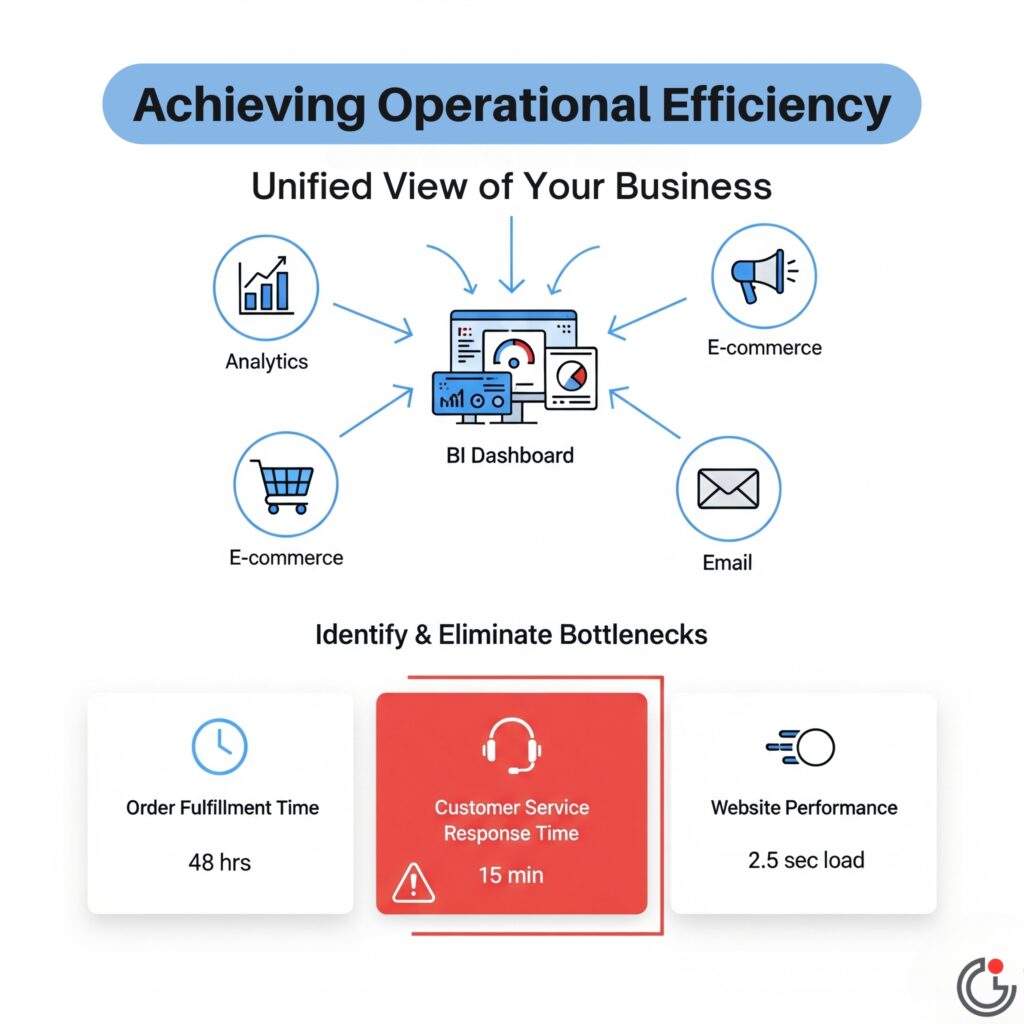
Running an online store involves a complex web of operations, from marketing and sales to fulfillment and customer service. BI acts as a central nervous system, connecting these disparate parts and streamlining your entire workflow.
Unified View of Your Business
Instead of logging into five different platforms (Google Analytics, Shopify, Facebook Ads, Mailchimp, etc.) and trying to piece together the story from separate spreadsheets, a BI dashboard consolidates all your key metrics in one place. This single source of truth saves countless hours and ensures everyone on your team is working with the same information.
Identify and Eliminate Bottlenecks
BI dashboards can help you monitor operational performance in real-time. You can track metrics like:
- Order Fulfillment Time: How long does it take from when an order is placed to when it’s shipped?
- Customer Service Response Time: Are support tickets being handled efficiently?
- Website Performance: Is your site speed slowing down, affecting user experience?
By monitoring these Key Performance Indicators (KPIs), you can quickly spot inefficiencies and address them before they become major problems, ultimately reducing operational costs.
6. Power Hyper-Personalized Marketing and CX
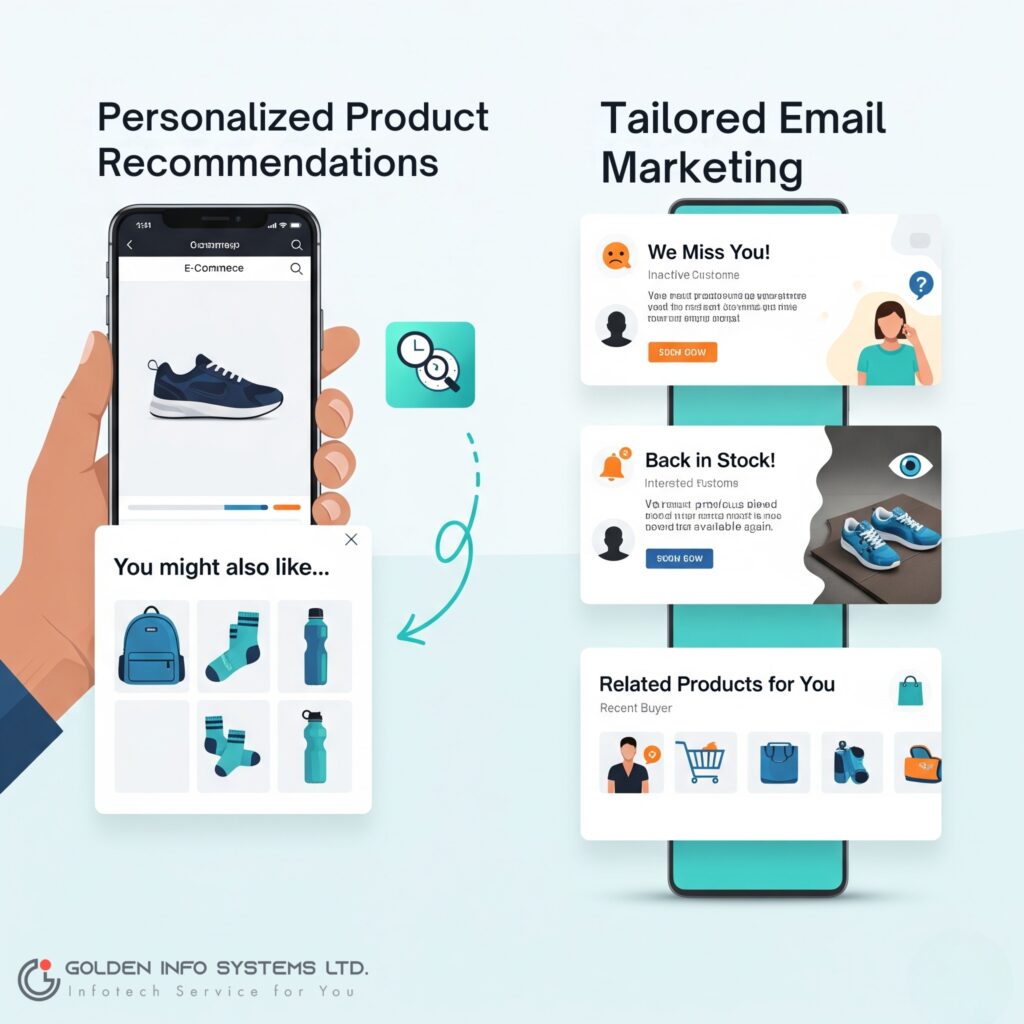
In 2025, personalization is no longer a luxury; it’s an expectation. Customers crave experiences that feel tailored to them. BI is the engine that drives true, data-led personalization.
Personalized Product Recommendations
You’ve seen this on Amazon: “Customers who viewed this item also viewed…” This is BI in action. By analyzing Browse and purchase history, you can create highly relevant product recommendations for each user. This not only improves the customer experience (CX) but also significantly boosts AOV and conversion rates.
Tailored Email Marketing Campaigns
Armed with detailed customer segments, you can craft email campaigns that speak directly to the recipient’s interests.
- Send a “we miss you” discount to customers who haven’t purchased in six months.
- Notify shoppers when an item they previously viewed is back in stock or on sale.
- Promote accessories related to a customer’s recent purchase.
This level of personalization makes your marketing feel helpful rather than intrusive, building stronger customer relationships.
7. Gain a Sustainable Competitive Advantage
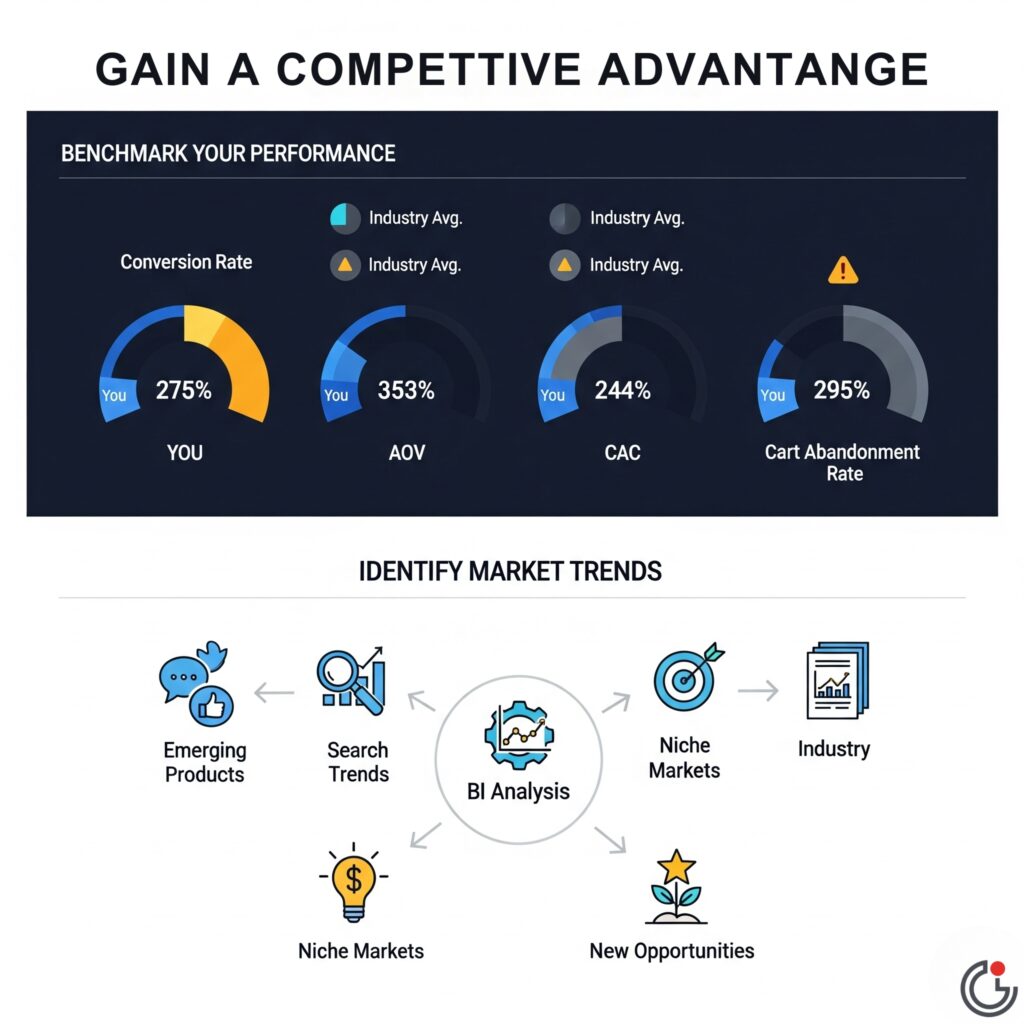
In the crowded e-commerce marketplace, your ability to outsmart the competition is key to long-term survival and growth. Business Intelligence provides the insights you need to stay several steps ahead.
Benchmark Your Performance
How does your online store stack up against the competition or industry averages? BI allows you to benchmark your performance across critical metrics like:
- Conversion rate
- Average Order Value (AOV)
- Customer acquisition cost (CAC)
- Cart abandonment rate
If your cart abandonment rate is 75% while the industry average is 68%, you know you have a specific problem to address. This data-driven benchmarking focuses your efforts on the areas that will yield the biggest competitive improvements.
Identify Market Trends and New Opportunities
BI isn’t just about looking at your own data; it can also be used to analyze broader market trends. By monitoring social media conversations, search trends, and industry reports, you can:
- Spot emerging product trends before they become mainstream.
- Identify underserved niches in the market.
- Anticipate shifts in consumer behavior and adapt your strategy accordingly.
This foresight allows you to be a market leader, not a follower.
8. Enhance Financial Planning and Forecastin

A clear view of your financial health is non-negotiable. BI transforms complex financial data into clear, intuitive visualizations, making financial planning more accurate and less stressful.
Real-Time Revenue and Profit Tracking
Forget waiting for end-of-month reports. With a BI dashboard, you can monitor your revenue, costs, and profit margins in real-time. You can drill down to see the profitability of individual products, categories, or marketing campaigns. This enables you to make swift decisions, such as discontinuing a product that is selling at a loss or investing more in a highly profitable ad campaign.
More Accurate Budgeting
Accurate historical data and reliable sales forecasts are the cornerstones of effective budgeting. BI provides both. You can create your annual or quarterly budgets with confidence, allocating resources to different departments (marketing, product development, etc.) based on proven performance and projected growth, rather than speculation.
9. Reduce Cart Abandonment
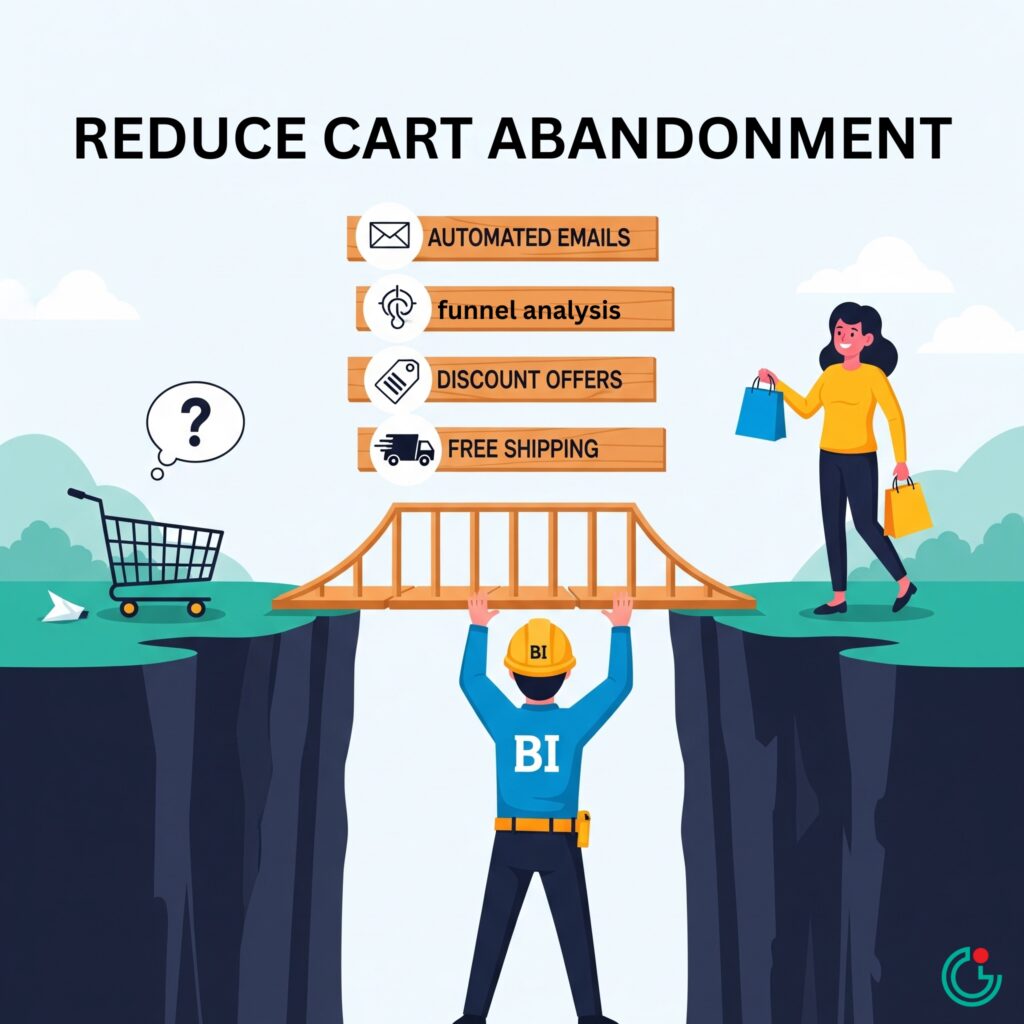
Cart abandonment is the bane of every e-commerce manager’s existence. The average cart abandonment rate hovers around 70%, representing a massive amount of lost revenue. BI is one of your most powerful tools in the fight to recover these sales.
Pinpoint the “Why”
As mentioned earlier, BI helps you identify where users drop off, but it also helps you understand why. By integrating data from customer surveys, exit-intent pop-ups, and live chat logs with your funnel analysis, you can build a comprehensive picture of the friction points. Common culprits revealed by data include:
- Unexpectedly high shipping costs.
- A requirement to create an account.
- A lack of trust seals or security badges.
- A non-mobile-friendly checkout process.
Automate Recovery Campaigns
Once you know why users are leaving, you can set up automated email sequences to win them back. A BI system can trigger an email to be sent an hour after a cart is abandoned, perhaps including a picture of the items left behind and a small discount or free shipping offer to entice them back. Tracking the success rate of these campaigns within your BI tool allows you to continuously refine your approach.
10. Improve Product Merchandising and Catalog Layout
How you display products on your site can have a huge impact on sales. BI provides objective data to guide your visual merchandising strategy.
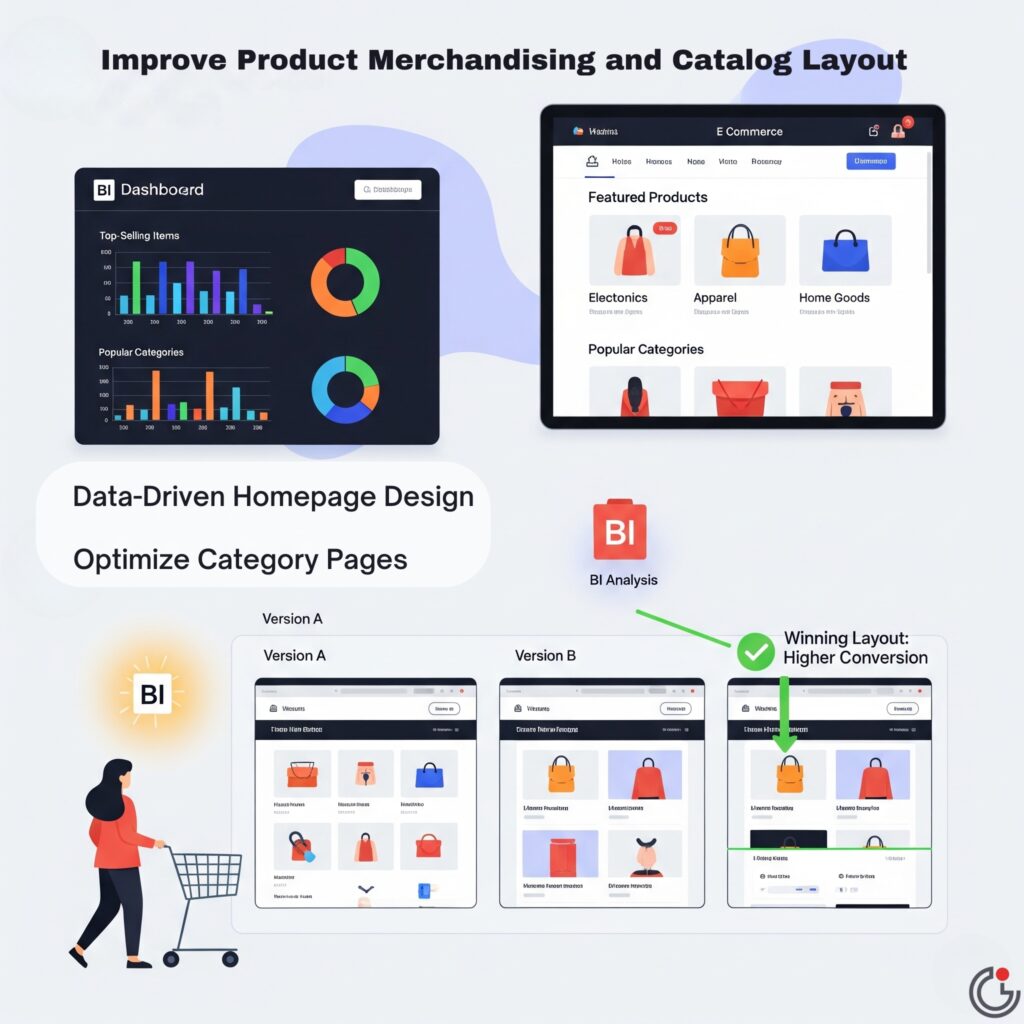
Data-Driven Homepage Design
What should you feature on your homepage? Your data has the answer. A BI dashboard can instantly show you your top-selling products, most-viewed categories, and highest-converting items. Use this information to populate your homepage banners and featured product sections to ensure you’re putting your best foot forward.
Optimize Category Pages
By analyzing click-through rates and conversion rates for products within a category, you can learn how to best sort them. Should the default sort order be “Best Selling,” “Newest,” or “Price: Low to High”? You can test different layouts and use your BI tool to measure the impact on sales, providing a definitive, data-backed answer.
11. Foster a Data-Driven Culture
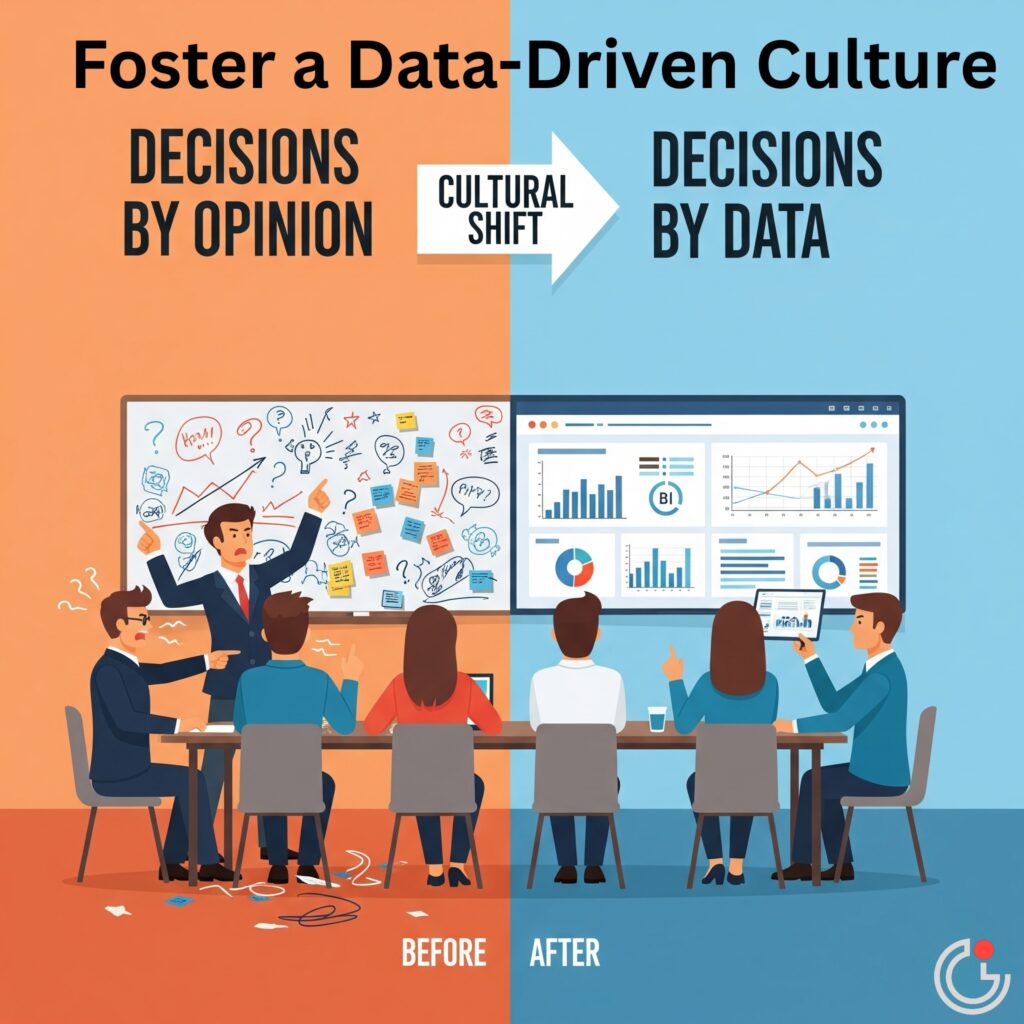
Perhaps the most profound benefit of implementing BI is the cultural shift it creates within your organization. When data is accessible and understandable for everyone—from the marketing team to the warehouse manager—it empowers your entire team to make smarter decisions.
Decisions are no longer based on seniority or the “loudest voice in the room.” Instead, they’re based on objective, verifiable data. This leads to more innovative ideas, more effective strategies, and a team that is fully aligned and focused on common goals. It creates a cycle of continuous improvement, where you constantly measure, analyze, and optimize every facet of your online store.
From Data-Rich to Insight-Rich
In today’s digital landscape, every online store is rich with data. The difference between a struggling store and a thriving one often comes down to how that data is used. Simply collecting data isn’t enough; you need to transform it into actionable insights.
Business Intelligence is the bridge that connects your raw data to smarter decisions and sustainable growth. By providing a deeper understanding of your customers, optimizing your pricing and inventory, personalizing the shopping experience, and streamlining your operations, BI gives you an unparalleled advantage. It’s not just a tool; it’s a fundamental shift in how you run your business—a shift towards clarity, efficiency, and profitability.
Ready to stop guessing and start growing? It’s time to put your data to work.
Frequently Asked Questions (FAQ)
What is Business Intelligence (BI) in the context of an online store?
Business Intelligence (BI) is the process of using technology to collect, analyze, and visualize data from your online store. It transforms raw sales figures, customer behavior, and operational data into clear, actionable insights. For an e-commerce business, this means using tools like Power BI or Tableau to understand customer patterns, optimize inventory, and make smarter, data-driven decisions to boost sales and efficiency.
How can a small online store benefit from BI?
Small online stores can see immense benefits from BI. It helps you compete with larger retailers by:
- Understanding Your Customers: Pinpoint who your most valuable customers are and what they want.
- Optimizing Inventory: Avoid tying up cash in slow-moving products and prevent stockouts of popular items.
- Improving Marketing: Stop wasting money on ads that don’t work and focus your budget on campaigns that deliver the best ROI.
- Increasing Sales: Identify and fix issues in your checkout process to reduce abandoned carts.
Even with a small budget, tools like Google Data Studio offer powerful, free starting points for BI.
Is Business Intelligence too complicated for someone without a technical background?
No, it doesn’t have to be. Modern BI platforms are designed to be user-friendly, with drag-and-drop interfaces and pre-built templates. While the technology behind BI is complex, the goal of these tools is to make data accessible to everyone, not just data scientists. Many platforms offer extensive tutorials and support to help non-technical users get started with creating insightful dashboards for their online store.
What’s the difference between Business Intelligence and Google Analytics?
Google Analytics is a powerful tool for web analytics, focusing primarily on website traffic, user behavior on your site, and conversions. Business Intelligence is broader. A BI system can pull in data from Google Analytics and combine it with data from many other sources, such as your Shopify or Magento platform, inventory system, CRM, accounting software, and advertising platforms (like Facebook Ads and Google Ads). This gives you a complete, unified view of your entire business performance, not just your website’s performance.
How does BI help increase an online store’s profit?
BI increases profit in several key ways. It helps you implement strategic pricing to maximize revenue without scaring off customers. It enables accurate demand forecasting, which reduces costly overstocking and prevents lost sales from stockouts. By optimizing your marketing spend and streamlining operations like order fulfillment, BI directly reduces your costs. Finally, by helping you create a personalized shopping experience, it increases customer loyalty and lifetime value, which are major drivers of long-term profitability.
What are the first steps to implementing BI for my e-commerce business?
- Define Your Goals: Start by identifying what you want to achieve. Do you want to reduce cart abandonment, increase average order value, or understand customer loyalty?
- Identify Your Data Sources: List all the places your data lives (e.g., Shopify, Google Analytics, Mailchimp, QuickBooks).
- Choose a BI Tool: Select a platform that fits your budget and technical comfort level. Popular choices include Google Data Studio (free), Microsoft Power BI, and Tableau.
Start Small: Connect one or two key data sources first. Build a simple dashboard that tracks your most important metrics (KPIs) and expand from there as you get more comfortable.











